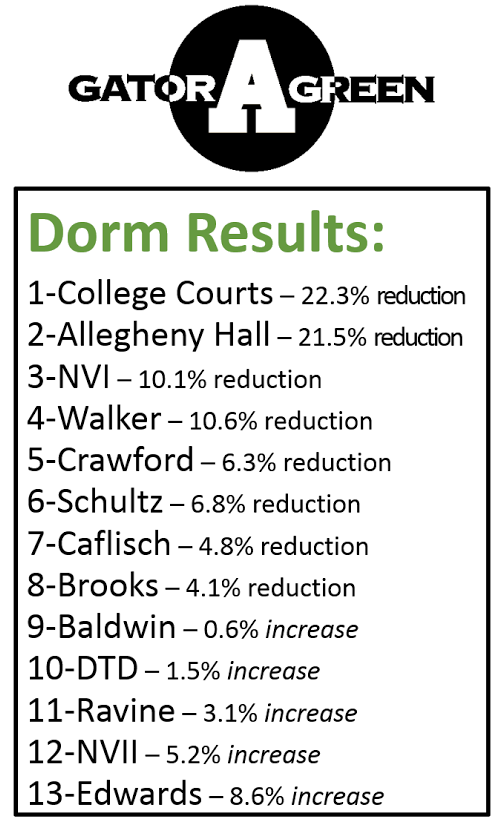2017 Energy Challenge sets new records
Campus saves $16,700 in net reduction
The eighth annual energy challenge charged Allegheny students up to achieve a 14.2 percent reduction in electricity consumption, saving $16,700 for use in more eco-friendly projects on campus. Events ranging from a Night Hike to Yoga in the Dark contributed to the energy challenge improving upon 2016’s 13.2 percent reduction, and student efforts saved $5,700 more than last year’s $11,000 total.
During the challenge, Allegheny Sustainability Coordinator Kelly Boulton, ’02, tracked the energy reduction in specific academic buildings and dormitories. The Vukovich Center for Communication Arts, Carnegie Hall and Quigley Hall had the largest increases among academic buildings while College Court, Allegheny Hall and North Village I led the list of reductions among dorm buildings.
This year’s energy challenge schedule was a blend of old favorites and new ideas, as student organizations combined their efforts to create an 11-event agenda for the month of October. Akeem Adesiji ’20, sustainability coordinator for Allegheny Student Government and co-president of Students for Environmental Action, noted the particular success of the Food and Fire Gathering.
“We did a food and fire event with Students for Environmental Action and Edible Allegheny, and that was really well-attended, we had a lot of people come,” Adesiji said. “They were all a lot of fun. All of the events that I went to were really cool.”
The fun and student enjoyment was a reflection of the goals for this year’s challenge. Boulton said the best way to get students involved with the challenge is to make the events interesting.
“It seems like a good way to sustain the talk of it because what I don’t think is effective is nagging people, so we try to keep it fun and engaging,” Boulton said.
Keeping students engaged was key throughout the challenge. Boulton worked in conjunction with ASG and SEA to ensure that student voices were heard, and Adesiji said ASG collaborated with SEA to generate possible projects the challenge could fund.
“We worked with Students for Environmental Action and we brainstormed a big list of potential ways to spend the money, we distilled that list down to five potential options. We put that list out online and asked students how they wanted to see the money spent,” Adesiji said.
Students chose for the second year in a row to use the money for more filtered water refill stations on campus. This year, students expressed a particular desire to have these stations in residence halls.

Final results show percentages for residence halls on campus. The energy challenge resulted in an overall 14.2 percent reduction in electricity consumption between Oct. 6 and Nov. 3, 2017.
Boulton and student coordinators are already looking ahead to next year’s energy challenge. Akeem Adesiji said he believes one of the opportunities for improvement is better informing the campus community about the events that go into the challenge.
“I think that there are some things we could do for next year to clear up some misconceptions,” Adesiji said. “I think that as far as the events that we have, they’re all really great events. I think that as we do a better job getting the word out about the energy challenge, we’ll start to see more participation in those events but the way that they’re being run is really great right now.”
Boulton and her assistant, Autumn Blaisdell, ’21, are also looking to make changes in the 2018 energy challenge and beyond. Blaisdell said that she and Boulton are planning to make major changes to the running and publication of the energy challenge for next year.
“The most pivotal reason for doing this reform is to try and get more students to participate in the event and make them more aware of their energy use in the hope that they will want to consume less energy even if it’s not during a challenge,” Blaisdell said.
Blaisdell went on to say that these reforms are meant to serve the larger goal of this year’s challenge, like the ones before it: to integrate awareness of energy use into student’s lives. Beth Choate, assistant professor of environmental science, spoke to this larger purpose of the Allegheny energy challenge.
“We do see decreases in energy use from year to year but can we see sustained decreases, can we see behavior changes in people?” Choate said.






